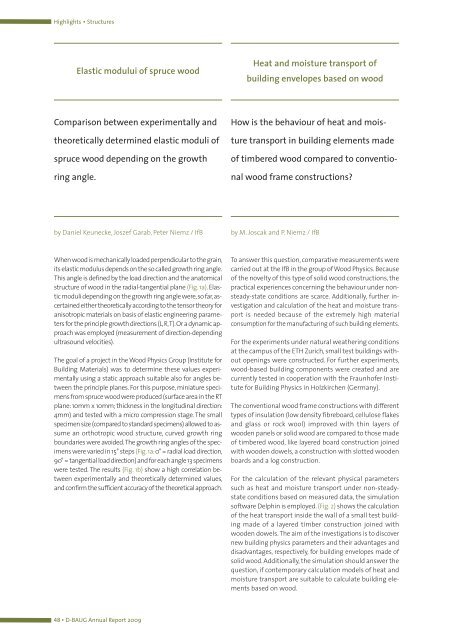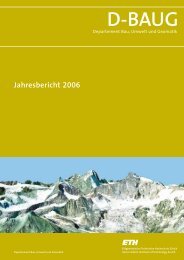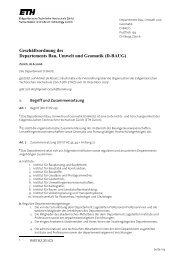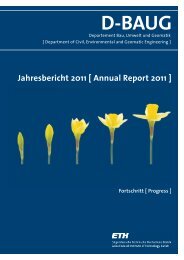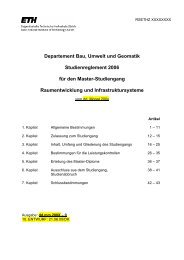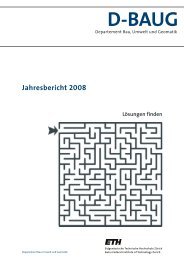D-BAUG - Departement Bau, Umwelt und Geomatik - ETH Zürich
D-BAUG - Departement Bau, Umwelt und Geomatik - ETH Zürich
D-BAUG - Departement Bau, Umwelt und Geomatik - ETH Zürich
Create successful ePaper yourself
Turn your PDF publications into a flip-book with our unique Google optimized e-Paper software.
Highlights ▪ Structures<br />
Elastic modului of spruce wood<br />
Comparison between experimentally and<br />
theoretically determined elastic moduli of<br />
spruce wood depending on the growth<br />
ring angle.<br />
When wood is mechanically loaded perpendicular to the grain,<br />
its elastic modulus depends on the so called growth ring angle.<br />
This angle is defined by the load direction and the anatomical<br />
structure of wood in the radial-tangential plane (Fig. 1a). Elastic<br />
moduli depending on the growth ring angle were,so far,ascertained<br />
either theoretically according to the tensor theory for<br />
anisotropic materials on basis of elastic engineering parameters<br />
for the principle growth directions (L,R,T).Or a dynamic approach<br />
was employed (measurement of direction-depending<br />
ultraso<strong>und</strong> velocities).<br />
The goal of a project in the Wood Physics Group (Institute for<br />
Building Materials) was to determine these values experimentally<br />
using a static approach suitable also for angles between<br />
the principle planes. For this purpose, miniature specimens<br />
from spruce wood were produced (surface area in the RT<br />
plane: 10mm x 10mm; thickness in the longitudinal direction:<br />
4mm) and tested with a micro compression stage. The small<br />
specimen size (compared tostandardspecimens) allowed to assume<br />
an orthotropic wood structure, curved growth ring<br />
bo<strong>und</strong>aries were avoided.The growth ring angles of the specimens<br />
were varied in 15° steps (Fig.1a:0° = radial load direction,<br />
90° = tangential load direction) and for each angle 13 specimens<br />
were tested. The results (Fig. 1b) show a high correlation between<br />
experimentally and theoretically determined values,<br />
and confirm the sufficient accuracy of the theoretical approach.<br />
48 ▪ D-<strong>BAUG</strong> Annual Report 2009<br />
Heat and moisture transport of<br />
building envelopes based on wood<br />
How is the behaviour of heat and mois-<br />
ture transport in building elements made<br />
of timbered wood compared to conventio-<br />
nal wood frame constructions?<br />
by Daniel Keunecke, Joszef Garab, Peter Niemz / IfB by M. Joscak and P. Niemz / IfB<br />
To answer this question, comparative measurements were<br />
carried out at the IfB in the group of Wood Physics. Because<br />
of the novelty of this type of solid wood constructions, the<br />
practical experiences concerning the behaviour <strong>und</strong>er nonsteady-state<br />
conditions are scarce. Additionally, further investigation<br />
and calculation of the heat and moisture transport<br />
is needed because of the extremely high material<br />
consumption for the manufacturing of such building elements.<br />
For the experiments <strong>und</strong>er natural weathering conditions<br />
at the campus of the <strong>ETH</strong> Zurich, small test buildings without<br />
openings were constructed. For further experiments,<br />
wood-based building components were created and are<br />
currently tested in cooperation with the Fraunhofer Institute<br />
for Building Physics in Holzkirchen (Germany).<br />
The conventional wood frame constructions with different<br />
types of insulation (low density fibreboard, cellulose flakes<br />
and glass or rock wool) improved with thin layers of<br />
wooden panels or solid wood are compared to those made<br />
of timbered wood, like layered board construction joined<br />
with wooden dowels, a construction with slotted wooden<br />
boards and a log construction.<br />
For the calculation of the relevant physical parameters<br />
such as heat and moisture transport <strong>und</strong>er non-steadystate<br />
conditions based on measured data, the simulation<br />
software Delphin is employed. (Fig. 2) shows the calculation<br />
of the heat transport inside the wall of a small test building<br />
made of a layered timber construction joined with<br />
wooden dowels. The aim of the investigations is to discover<br />
new building physics parameters and their advantages and<br />
disadvantages, respectively, for building envelopes made of<br />
solid wood. Additionally, the simulation should answer the<br />
question, if contemporary calculation models of heat and<br />
moisture transport are suitable to calculate building elements<br />
based on wood.


